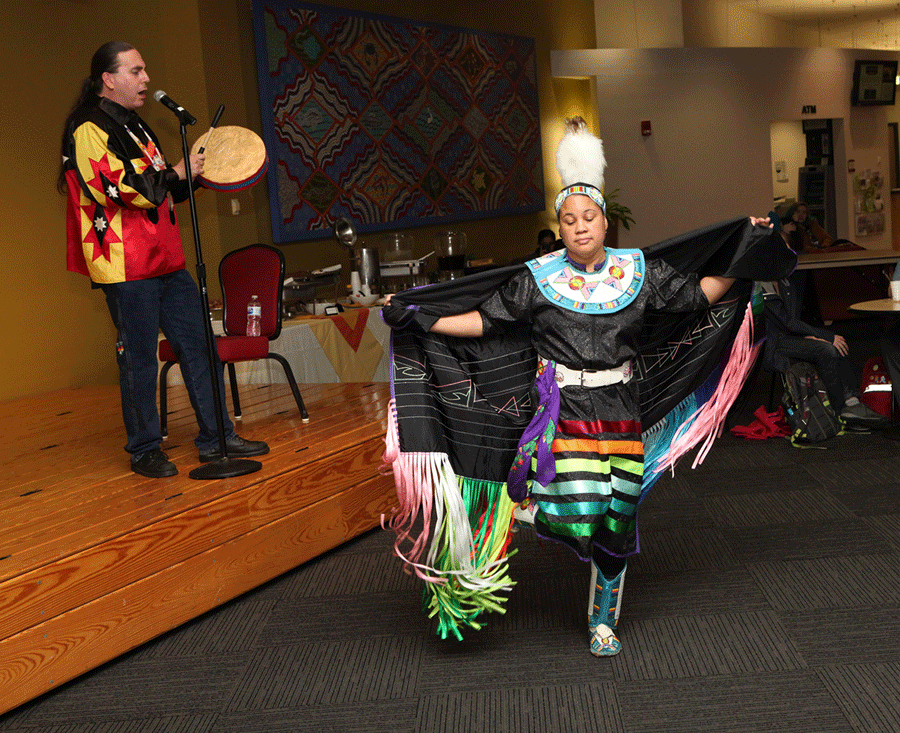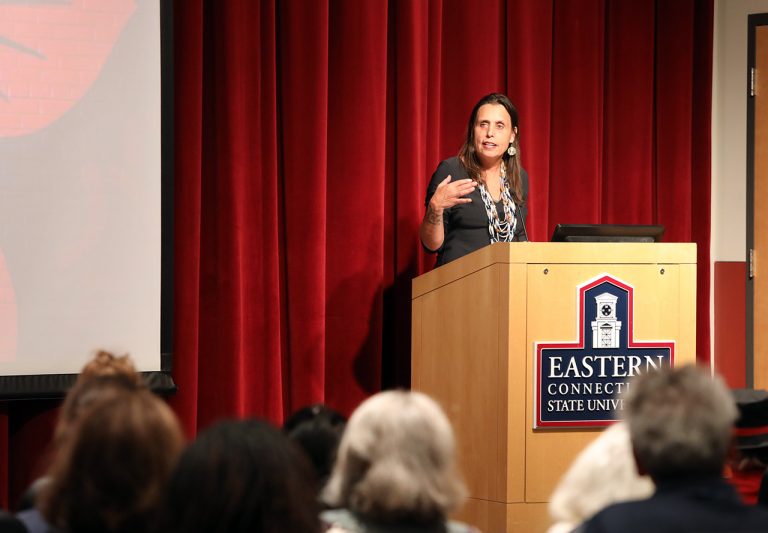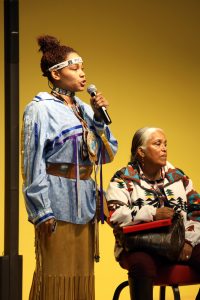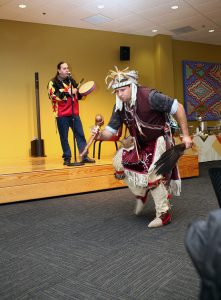


Published on November 28, 2018

Demonstrations of Native dancing by members of the Mohegan and Mashantucket Pequot tribes rounded out the Native American Heritage Day of Events on Nov. 13.
Eastern Connecticut State University held several events in commemoration of Native American Heritage Month in November. Events featured prominent figures and speakers from the local Native American community – including internationally acclaimed author and environmental activist Winona LaDuke of the Anishinaabe Tribe as well as Chief Marilynn Malerba of the local Mohegan Tribe. The celebration also included demonstrations of music, jewelry making and natural medicines.
There are currently 573 tribes recognized by the federal government according to The Bureau of Indian Affairs. All federally recognized tribes are sovereign and self-governing nations that maintain a government-to-government relationship with the United States. Each indigenous nation has a distinct history, language and culture.
Native American Heritage Month serves to educate the public about the challenges faced by Native people currently and historically as well as the ways in which tribal citizens and communities have worked to address these challenges.
There are two federally recognized Native American tribes in Connecticut – the Mashantucket Pequot Nation and the Mohegan Tribe. However, there are several other tribes, bands and communities in Connecticut that don’t have federal recognition, including the Schaghticoke Indian Tribe, Paucatuck Eastern Pequot Tribe and Eastern Pequot Tribal Nation.
Many Native communities are not recognized by the federal government, as obtaining federal recognition requires extensive documentation, which is particularly difficult for the many Native communities that have oral histories with little written down. Without recognition, communities aren’t eligible for certain services and have limited rights to self-governance. The Eastern Pequots lost their federal status on Oct. 12 (Columbus Day), 2005.

The first event of Native American Heritage Month occurred on Oct. 31 and featured internationally acclaimed author and environmental activist Winona LaDuke of the Anishinaabe Tribe. LaDuke’s talk, “A Native Perspective: Sustaining Our Land, Recovering the Sacred,” explored how indigenous understandings of land, religion and sacredness influence strategies for a sustainable environment.
The current and historical territorial dispossession of indigenous peoples often goes hand in hand with natural resource exploitation. LaDuke discussed how the exploitation of natural resources threatens Native communities, as well as the necessity for utilizing renewable forms of energy. This exploitation often violates treaty rights, threatens the environment and contributes to climate change.
LaDuke is the executive director of Honor the Earth, a non-profit organization that raises awareness and financial support for indigenous environmental justice. The organization recently played an active role in the Dakota Access Pipeline protests. LaDuke was also involved in stopping work on the Sandpiper Pipeline in northern Minnesota in 2015.
Eastern hosted Chief Marilynn Malerba of the Mohegan Tribe on Nov. 7 at 3 p.m. in the Student Center Theatre. Malerba is the 18th chief of the Mohegan Tribe and is the first female chief in the tribe’s modern history. Malerba spoke of many issues affecting Native communities throughout the nation including land rights, voting rights, rates of poverty and unemployment, violence – particularly against women and children – suicide, drug and alcohol abuse rates, educational shortcomings and healthcare inadequacies. “American Indian activism is needed now more than ever,” she said.

Malerba focused on the tendency for Native communities to experience poverty and joblessness. Seventeen percent of Native Hawaiians and Pacific Islanders and 27 percent of all self-identified Native Americans and Alaska Natives live in poverty, according to U.S. Census Bureau data.
“The living conditions for Natives on reservations are often of poor quality,” said Malerba. “On many reservations the electricity is subpar, plumbing is subpar or nonexistent, the roads need renovating and the homes are overcrowded.” Malerba’s assertions are supported by data from the National Congress of American Indians, which states that 40 percent of Natives who live on reservations are in substandard housing, one-third of homes are overcrowded and less than 16 percent have indoor plumbing.

Also discussed was the shockingly high rates of violence against women and children in Native communities. According to the Connecticut Alliance to End Sexual Violence, American Indians are the victims of rape and sexual assault at a rate more than three times higher than that of any other race in the United States. Furthermore, while the majority of survivors of sexual assault are victimized by a family member or intimate partner, American Indian and Alaska Native women are more likely to be victims of sexual violence committed by a stranger or acquaintance outside of the tribal community, with 70 percent of perpetrators being non-Native. This creates unique challenges for tribal communities in adjudicating cases of sexual assault, leading to lower prosecution and a lack of justice for Native survivors of sexual violence.
Malerba also discussed the massive disparities in health care for Native Americans as compared to the general population. Although Native Americans are able to receive health care through Indian Health Services (IHS), like many other federal agencies that serve Native people, the IHS suffers from a lack of funding. As a result, one in three Natives are uninsured and lacking proper healthcare. According to the Center for Disease Control, Natives suffer from high rates of diabetes, obesity, substance abuse, HIV and other sexually transmitted diseases.
Another epidemic facing Native communities is youth suicide. According to U.S. Census data, suicide is the second most common cause of death for Native youth ages 15 to 24 – two and a half times the national rate for that age group.
“Maintaining a connection with their tribe lowers the suicide rate for indigenous youth, among serving them in other ways,” said Malerba. “The Indian Child Welfare Act is not highly regarded and indigenous children are still being displaced. This contributes greatly to an increased risk of suicide.”

Malerba also stressed voter suppression as a major issue for Native communities. “Only about two percent of the U.S. population is made up of American Indian and Alaskan Native people,” said Malerba. “We can’t move mountains with elections. We need other people to care about and rally toward Native rights.” Some factors that contribute to voter suppression are lack of official addresses on most reservations and the distance of polling places from reservations.
Malerba ended her informative talk with an important lesson: “Have a large voice when you’re offered a seat at the table. Advocate for what you think is right.”
The month of recognition and celebration continued on Nov. 13 with the “Native American Heritage Day of Events.” Lessons in jewelry design were led by Natasha Gambrell ’15 of the Eastern Pequot Tribe. An interactive program featuring a variety of Native music was also held by Chris Newell, a singer and senior educator of the Mashantucket Pequot Museum.
Native American Heritage Month events were co-sponsored by the Intercultural Center, Arthur L. Johnson Unity Wing, the Office of Equity and Diversity, the Institute of Sustainable Energy and the Department of Sociology, Anthropology, Criminology and Social Work.
Written by Jolene Potter